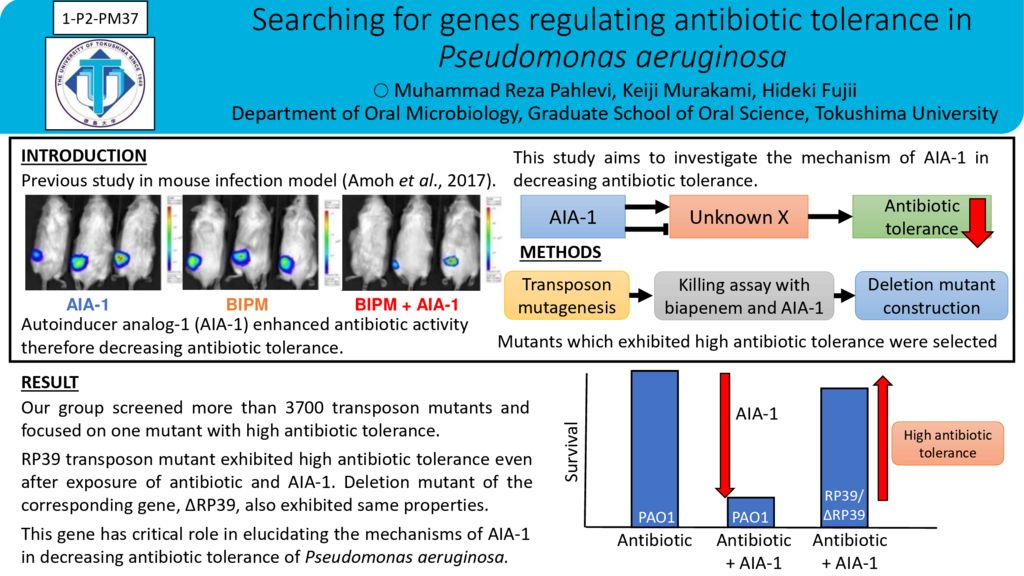Author: 〇パレヴィ ムハンマドレザ1、村上 圭史2、藤猪 英樹1
Affiliation: 1徳島大学大学院医歯薬学研究部口腔微生物学分野、2川崎医療福祉大学
Abstract:
Purpose
Antibiotic tolerance is a phenomenon in which bacteria cannot grow but does not die in the presence of antibiotic. Bacteria responds to antibiotic by changing its gene expression to maintain survival. Pseudomonas aeruginosa is one of microorganisms that has high antibiotic tolerance properties which makes it very difficult to eradicate. This microorganism is a serious threat to immunocompromised patients and a major cause of nosocomial infection. Previous study demonstrated a new compound, autoinducer analog-1 (AIA-1), which enhance antibacterial activity of antibiotics without affecting antibiotic susceptibility. The mechanism of this compound in decreasing antibiotic tolerance remains to be explained. This study aims to investigate the mechanism of AIA-1 in decreasing antibiotic tolerance.
Materials and Methods
Transposon mutagenesis was done by conventional mating between wild type Pseudomonas aeruginosa (PAO1) and Escherichia coli S17-1 λ-pir harboring pUT-miniTn5pro. Killing assay was performed using Biapenem or combination of Biapenem and AIA-1. Mutants which exhibited high antibiotic tolerance were selected. Transposon insertion site were determined by sequencing and genes obtained from the transposon mutant screening were designated to be deleted. To construct deletion mutants, five hundred base pairs of upstream and downstream of gene target were amplified and aligned to pEX18Gm vector. Deletion mutants were obtained by mobilizing In-Fusion plasmid from E. coli S17-1 λ-pir to PAO1.
Results
In this study, more than 3700 transposon mutants were screened for high antibiotic tolerance properties. Six mutants were selected and six genes were identified from sequencing. Analysis was focused on one of transposon mutants, RP39, which had transposon insertion site on a gene that encodes conserved hypothetical protein. Deletion mutant of this gene were constructed and killing assay using Biapenem, Levofloxacin and combination of these antibiotics and AIA-1 was done. ΔRP39 exhibited high antibiotic tolerance despite the presence of antibiotics and AIA-1.
Conclusion
The new compound, AIA-1, may have the effect towards antibiotic tolerance by affecting gene that analyzed in this study. This gene has critical role in elucidating the mechanisms of AIA-1 in decreasing antibiotic tolerance of Pseudomonas aeruginosa.
[1-P2-PM37] 緑膿菌の抗菌薬耐性を調節する遺伝子の検索
 微生物
微生物0
 メールで問い合わせ
メールで問い合わせ

コメント